The MacBook Air: Thoroughly Reviewed
by Anand Lal Shimpi on February 13, 2008 12:00 AM EST- Posted in
- Mac
Hard Drive Swap: DIY SSD Install
Samsung is the sole supplier for both the solid state and mechanical hard drives in the MacBook Air. The mechanical drive is a Spinpoint N2 HS082HB/A while the SSD is the MCCOE64GEMPP.
DVNation offers the Samsung SSD for sale on its website and was kind enough to send us a drive so we could swap it into our MacBook Air. The drive swap process is pretty simple, first you have to remove the 10 screws that secure the base of the Air:
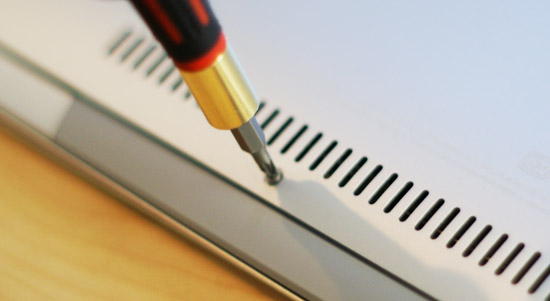

You'll want to keep track of where you pulled the screws out of, they are varying sizes
After removing the bottom panel you need to remove the battery:
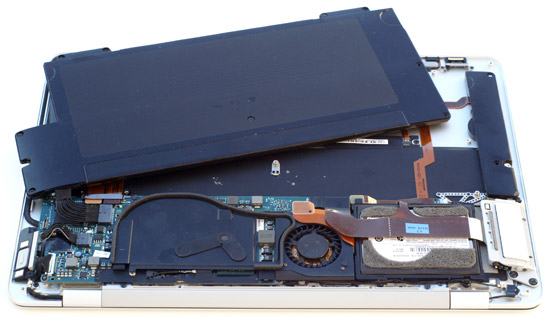
9 screws hold the battery in place - Click to Enlarge
With the battery removed you need to then remove the speaker, which is housed in the long black bar next to the battery:

Two screws hold the speaker in place
After the speaker is out you need to unscrew the flip-down ports on the Air (you should also disconnect the ribbon cable attached to the ports from the motherboard to make things easier):
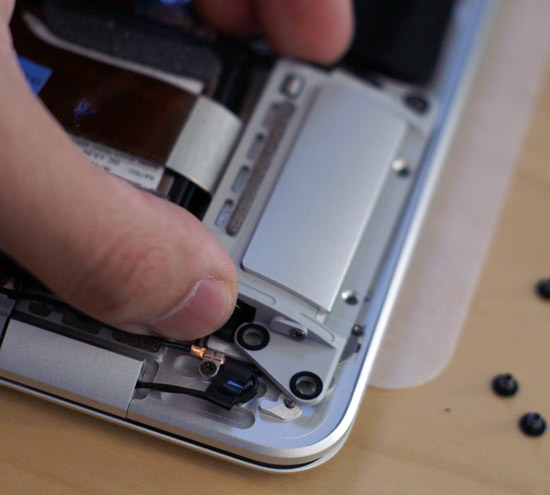
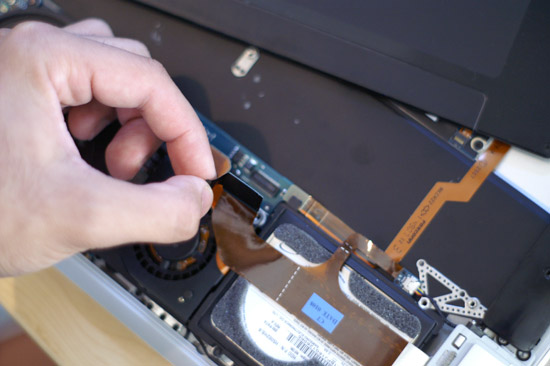
Disconnect this cable from the motherboard
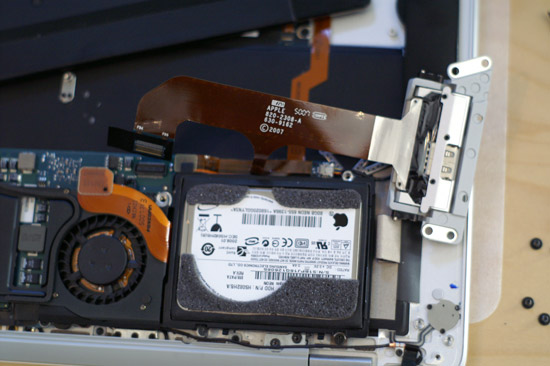
Then flip the ports out of the way
Now we can get to removing the hard drive itself. The hard drive is put inside a rubber frame and inserted into a plastic bracket, the bracket is then screwed into the Air's chassis. The bracket is held in by four screws, one of which is hidden by a removable cable guide:

Unscrew all four screws, disconnect the hard drive from the motherboard and you should be able to tilt the bracket out and away from the Air enough that you can just pop the drive out.
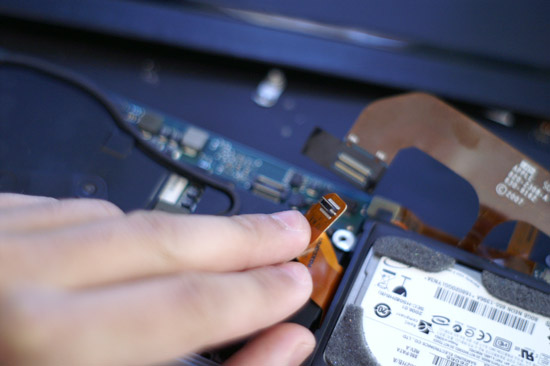
Unplug the HDD from the motherboard, just pull straight up on the connector to free it.

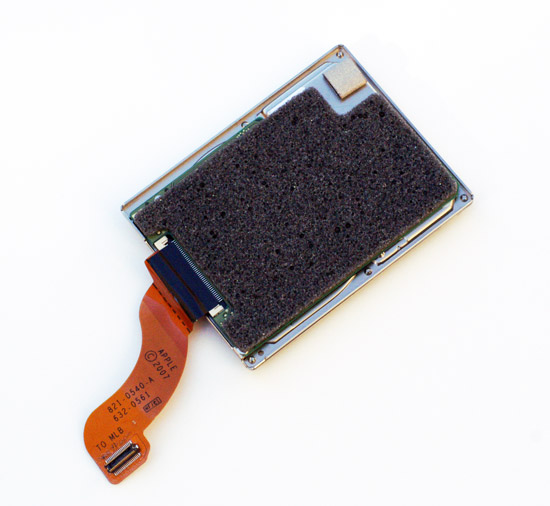
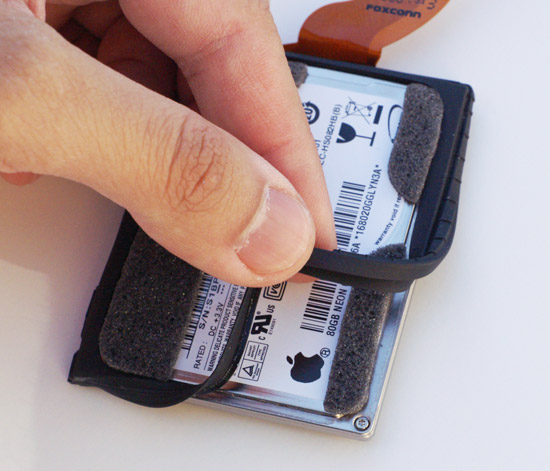
With the drive removed take off the rubber frame and stick it on your new drive.

There's a piece of black tape that helps hold the ZIF connector in place, peel it off; you'll probably need a replacement piece of tape as the one that ships with the Air is only good the first time, once you've removed it much of the adhesive is already gone.
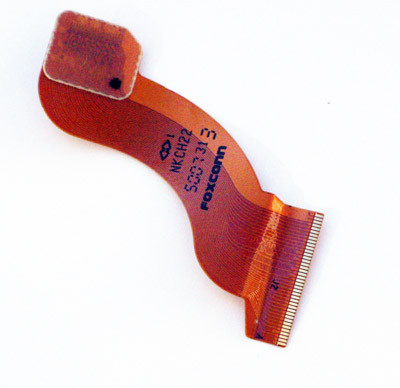










41 Comments
View All Comments
sprockkets - Wednesday, February 13, 2008 - link
I don't get it. I can use my Pioneer laptop slot loading burner on an external enclosure and it be powered solely via the one usb port and works just fine, even while writing to dvds.For that matter, I can do the same with notebook laptop drives. Rarely do I need both usb ports connected in order for it to work.
sprockkets - Wednesday, February 13, 2008 - link
Only about 16mbits per second on the xfer rate on wireless? Wow. Were you using n?JarredWalton - Thursday, February 14, 2008 - link
I don't know what Anand used, but I've seen everything from 3MBps to 12MBps on an 802.11n network... all with laptops in the same room, and many using the same chipset (Intel 4965AGN). Overall, N tends to feel about half as fast as 100Mbit Ethernet - or about twice as fast as 802.11G. Router choice unfortunately still has a major influence on 802.11N performance.Imaginer - Wednesday, February 13, 2008 - link
It is what the overall feel and message of the article indicates to me. It is a bit expensive, non-expansive, lacks most utility to be used in most mobile situations, and it is purely for computing on the bare minimum.Kind of like that so called weekend car. I don't think I myself will have ANY need for such a device. Give me a powerful desktop and a versitle yet remaining non cumbersome notebook anyday.
Most people in the market for a laptop usually would use it like their normal away from home computer and because of this, the air really disappoints. (not that I would invest in a new computer anytime soon).
jedmitchell - Wednesday, February 13, 2008 - link
hey, so good review overall -- kept it very even handed considering the difficulty of reviewing a niche product like this. one hardware point I'd like to mention though is the info you give on the X3100. certainly the idea behind it is that as an integrated controller it won't provide very fast graphics, but there's a trick here: most of the things it's not rated to run... run. at least on the older macBook (santa rosa). final cut pro, maya, and photoshop actually all run pretty seamlessly on the X3100, both in OSX and windows (fcp is more memory/drive limited there than GPU). the only small problems are in windows where the X3100 drivers by intel are actually lacking several openGL 2.0 features present in apple's version.the X3100 even plays older games on windows without much trouble -- I can run the Orange Box games at 1024x768 with high quality settings and see a fairly regular 30fps, less a few texture memory glitches. anyway, it would be interesting to see how that performance in the same chipset scales from the macBook to the air.
jdwango - Wednesday, February 13, 2008 - link
However I wish you had also tried to install Windows XP/Vista via boot camp and reported your thoughts.joey2264 - Wednesday, February 13, 2008 - link
This would be a fairly good review if you would just mention the fact that most of the sacrifices Apple made to create the Macbook Air simply weren't necessary. If you look like at a notebook like the Fujitsu Lifebook S6510 of the Lenovo X300 this becomes clear. Looking at these two notebooks, it is obvious that each of the manufacturers could have come up with a 13.3 in, 1 spindle notebook that didn't make hardly any other compromises (decent keyboard, decent port selection, replaceable battery, upgradeable memory, standard 2.5" hard drives (Lenovo could have probably fit a 2.5" hard drive in there if they had used a 13.3" screen, with the requisite larger footprint, although it would have been a little heavier), etc).michael2k - Wednesday, February 13, 2008 - link
The S6510 you mention is heavier (by a pound) and nearly twice as thick! It is much more comparable to a MacBook (5 pounds and an inch thick vs 4 pounds and 1.42 inches thick).The X300 is also not available yet, so a comparison will have to wait until we find out about price and build quality.
mlambert890 - Thursday, February 14, 2008 - link
OK, so then the Sony TX, the Fujitsu P7k, the Toshiba Portege, the Dialogue Flybook, the Panasonic Toughbook, the Dell XPS1210, the Sony SZ, The LG XNote....There's a pretty long list of notes that are smaller and ligher or as light or slightly heavier with a lot more features than the MBA.
The MBA is THINNER. Last I checked thinner is a BS feature. When someone can explain to me WHY thinner means ANYTHING beyond looking cool at Starbucks, maybe Ill be interested.
The Sony X505 was pretty much the same situation as the MBA except it had a removable battery and more ports and that was 3 years ago. I think the MBA was like .2" thinner than the Sony *at its thinnest point* and about the same at the thickest.
The MBA is big news for the cult of Mac which lately is including PC sites like this.
michael2k - Friday, February 15, 2008 - link
Fujitsu P7230: Too slow (one core at 1.2GHz vs two cores at 1.6GHz), half as much ram (1GB vs 2GB) for the same priceDell XPS 1330: You can't get a 1210 from Dell.com (one pound (33%)heavier) for 2/3 the price
Sony TZ250N: You can't get a TX from Sonystyle.com, too slow (2 cores at 1.2GHz vs 1.6Ghz), too expensive ($600 more)
Sony SZ750N: Too big and heavy (1 pound (33%) heavier and twice as thick) for the same price
You argue against thinner: Thinner is only a measure of weight. Compare to 3 pounds (2.7 to 3.2 pound) and you already eliminate the toughbook, the Dells, the Portege, and the SZ. Compare to the CPU speed and you eliminate the Fujitsu and Sony TZ.
So what is left? The Lenovo X300, which is still more expensive, but for that extra expense you get an optical drive.